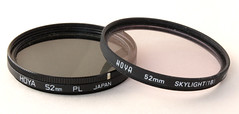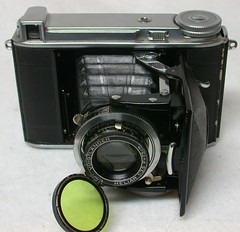Difference between revisions of "Filter"
(→Filters on telephoto lenses) |
(→Neutral) |
||
| Line 45: | Line 45: | ||
===Neutral=== | ===Neutral=== | ||
| − | [[Neutral density filter]]s (ND filters) merely reduce the level of transmitted light, without changing the colour. They are used in very bright conditions to allow a larger aperture | + | [[Neutral density filter]]s (ND filters) merely reduce the level of transmitted light, without changing the colour. They are used in very bright conditions to allow a larger aperture or shorter exposure time. |
===Special effect=== | ===Special effect=== | ||
Revision as of 21:47, 17 March 2012

|
| Polarising and Skylight filters for 52mm filter thread fitting image by AWCam (Image rights) |
A filter is an optical device that can be added to the lens of a camera. It consists of one or two glass (or, more recently, plastic or gelatine) plates, mounted in a frame that is fitted to the lens of a camera. Attachment may be push-fit, bayonet, or threaded. Also a filter may be built in to the camera or lens.
Colour filters reduce ("filter") light of a particular colour. Early colour filters were cuvettes which could be filled with coloured water. Nowadays colour filters consist of only one glass plate which is coated with a transparent glass colour.

|
| Voigtländer Bessa with hinged yellow filter image by Mark O'Brien (Image rights) |
In black and white photography colour filters can be used to improve contrast.
Filters can be grouped as: contrast enhancement, colour correction, neutral, and special effect.
Adding a poor quality filter can greatly degrade lens resolution, widely misunderstood is the high cost of optically flat filters with proper coatings necessary to preserve lens resolution.
Contents
Filter types
Contrast enhancement
In black-and-white photography coloured filters can be used to improve modelling of skin tones (green or yellow-green filters), or to darken washed-out skies and show cloud detail (e.g. yellow filter). Many box-type cameras, and some more sophisticated models, had built in yellow or green filters for these purposes. These filters work because black and white film does not have equal sensitivity for all colours.
For colour photography the main contrast enhancing filter is a polarising filter. In bright sunlight, especially when the sun is high, there are many reflections that will reduce contrast and, since reflections are plane polarised, a polarising filter can greatly reduce reflected light and enhance colour contrast as well as darkening blue sky.
Polarising filters come in two types, plane polarising and the misleadingly named "circular" polarising. Light waves have two properties, electro and magnetic. Plane polarising filters polarise both the same, causing problems for any camera with secondary mirrors for light measurement. "Circular" polarising filters, much more difficult to manufacture, polarise electro and magnetic seperately without secondary effects (simple "Polaroid" dark glasses cause very distracting patterns in car windscreens, "circular" polarised glasses do not).
So-called skylight filters, which block ultra-violet light and so improve colour rendering, are also contrast enhancing. However, most lenses already include UV coating (film is sensitive to UV, eyes are not).
Colour correction
The primary use of colour correction filters is to correct the colour balance of artificial light when taking photographs indoors or under tungsten lighting, such as on a film set or stage lighting. Early studio lighting was also tungsten and is still preferred by some photographers for its soft tones.
Blue filters are used to correct daylight colour film for tungsten lighting.
Correction filters are also available for tube (neon) lighting, however due to the nature of tube light they can only be partially successful.
Tinted filters can partly correct the very cold, blue, light typical of overcast conditions.
Neutral
Neutral density filters (ND filters) merely reduce the level of transmitted light, without changing the colour. They are used in very bright conditions to allow a larger aperture or shorter exposure time.
Special effect
Special effects filters are extremely varied, such as soft-focus and "sparkling" highlights. Such filters often degrade image quality more than standard filters.
Filters on wide angle lenses
On wide angle lenses light entering the edges of the filter at an angle will travel further through filter material than at the centre, where the light rays are perpendicular. This further increases vignetting from which all lenses suffer, especially wide angle. Worse still, the filter mount itself may obstruct light, especially if more than one filter is mounted.
A special, and unusual, neutral correction filter graduated from darker at the centre to clear at the edges can be used to reduce vignetting.
Extreme wide angle lenses are sometimes made with built in filters. The filters are fitted in a disc located towards the rear of the light path having much less effect on vignetting. A rotary dial on the lens is used to select clear or, most usually, orange and red monochrome contrast enhancement filters.
Filters on telephoto lenses
Large aperture telephoto lenses have large front apertures, making filters very expensive and, in extreme cases, impractical. Some extreme telephoto lenses are fitted with a rear filter slide in attachment. Various filters with a special mount may be fitted.